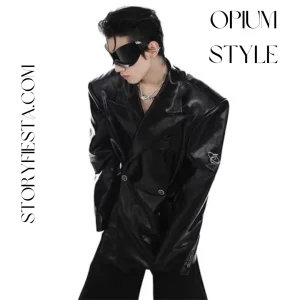Delve into the enigmatic world of Opium Style, a term that sparks intrigue and fascination. This unique style, while not broadly recognized in formal settings, opens a window to a realm where art, literature, fashion, and design converge, evoking the luxurious and exotic essence of the bygone opium dens. It’s a journey through time, bridging the historical opium trade’s impact with contemporary creativity.
What is Opium Style
Opium Style embodies an aesthetic deeply rooted in the allure of the East, blending Eastern charm and exotic furnishings with a touch of mystique. It transcends ordinary design paradigms, offering a decadent comfort through rich textiles, intricate patterns, and an immersive, dreamy ambiance reminiscent of the opium dens’ surreal environments.
History of Opium Style
Tracing its lineage back to the 19th and early 20th centuries, Opium Style draws inspiration from the opium trade’s cultural and social footprint across China and Southeast Asia. It reflects the dichotomy of opium’s allure and its profound societal impact, mirrored in art and literature that explore the opium dens’ dreamy, almost ethereal spaces.
Work of Opium Style in the Fashion Industry
In the fashion realm, Opium Style is synonymous with luxury and opulence, infusing garments with the mystique and elegance of Eastern traditions. Designers harness this style to craft collections that whisper tales of Chinese opulence and Japanese elegance, blending traditional Asian motifs with contemporary flair for a truly transcendent aesthetic.
Incorporating Opium-Style Elements into Home Decor
Transform your living space with opium-style elements that promise to transport you to an era of unmatched elegance and exoticism. Think silk drapes, bamboo furniture, and Ming dynasty-inspired designs that together create a sanctuary of peace and luxury, echoing the serene, Zen-inspired decor of Eastern philosophies.
The Cultural Significance of Opium-Style Decor in East Asian Traditions
Opium Style is more than just a design choice; it’s a deep dive into the heart of East Asian traditions, reflecting a profound respect for the cultural significance and historical depth of the regions most affected by the opium trade. It celebrates the resilience and beauty of these cultures, turning a dark chapter into an expression of creativity and enlightenment.
Opium Style Outfits
In the world of fashion, Opium Style Outfits stand as a remarkable testament to the allure and mystique of Eastern traditions, merged seamlessly with the decadent history of opium dens. These ensembles are more than mere clothing; they are a narrative woven in fabric, telling tales of luxury, intrigue, and a deep-seated connection to the past.
The Significance of Opium Style in Contemporary Fashion
The fashion industry’s embrace of Opium Style signifies a deeper connection to the historical and cultural narratives of East Asia. This style challenges the boundaries of modern fashion, blending historical references with contemporary design principles to create something truly unique. It’s a celebration of cultural fusion, showcasing how elements from the past can be reimagined in a modern context, offering wearers a piece of history while making a bold fashion statement.

Opium Style Fashion
Adopting Opium Style in fashion is not merely about aesthetic appeal; it’s an homage to the resilience and creativity of cultures impacted by the opium trade. These designs embody the strength and beauty of Eastern traditions, transforming a dark chapter of history into expressions of elegance and grace. Through Opium Style fashion, designers tell stories of cultural endurance, inviting us to appreciate the depth and richness of Eastern heritage.
Opium Style in Literature
Opium Style’s influence extends beyond the realms of fashion, permeating literature with its themes of fantasy, escapism, and the human psyche’s intricate layers. Literary works exploring the opium dens’ dreamlike worlds or the societal impacts of opium addiction delve deep into the human condition, offering readers a glimpse into the surreal and often tumultuous experiences associated with opium use. These narratives serve as a bridge between reality and fantasy, reflecting the complex relationship between society, culture, and opium.
Frequently Asked Questions
What are the key features of opium-style furniture?
Opium-style furniture is characterized by its luxurious materials, intricate carvings, and designs that reflect East Asian influence, offering a blend of comfort and decadence.
How can I incorporate opium-style elements into my home decor?
Introduce rich textiles, exotic furnishings, and Eastern motifs to infuse your space with a sense of opium-style elegance and tranquility.
What historical influences contributed to the development of opium-style design?
The opium trade’s impact on society and culture in China and Southeast Asia heavily influenced the development of opium-style design, integrating historical elements with modern aesthetics.
Are there specific color palettes commonly associated with opium-style interiors?
Opium-style interiors often feature warm, rich colors alongside deep, vibrant hues to create a cozy yet sophisticated ambiance.
What cultural significance does opium-style decor hold in East Asian traditions?
Opium-style decor pays homage to the complex history and rich cultural tapestry of East Asia, transforming historical narratives into artistic expressions.
Conclusion
Opium Style is a testament to the power of design to both remember and reimagine the past. It’s a style that invites you to explore the depths of history, culture, and creativity, offering a unique perspective on the beauty that arises from blending diverse influences. Whether through the lens of fashion, interior design, or art, embracing Opium Style is an adventure into the heart of Eastern mystique and luxury, where every piece tells a story of opulence, resilience, and transcendence.

